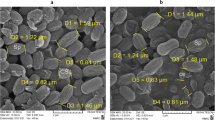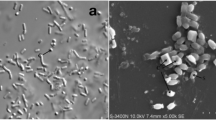Abstract
The aim of this study was to characterize new Bacillus thuringiensis strains that have a potent insecticidal activity against Ephestia kuehniella larvae. Strains harboring cry1A genes were tested for their toxicity, and the Lip strain showed a higher insecticidal activity compared to that of the reference strain HD1 (LC50 of Lip and HD1 were 33.27 and 128.61 μg toxin/g semolina, respectively). B. thuringiensis Lip harbors and expresses cry1Aa, cry1Ab, cry1Ac, cry1Ad and cry2A. DNA sequencing revealed several polymorphisms in Lip Cry1Aa and Cry1Ac compared to the corresponding proteins of HD1. The activation process using Ephestia kuehniella midgut juice showed that Lip Cry1A proteins were more stable in the presence of larval proteases. Moreover, LipCry1A proteins exhibited higher insecticidal activity against these larvae. These results indicate that Lip is an interesting strain that could be used as an alternative to the worldwide used strain HD1.




Similar content being viewed by others
References
Bertani G (1951) A method for detection of mutations, using streptomycin dependence in Escherichia coli. Genetics 36:598–611
Bradford MM (1976) A rapid and sensitive method for the quantitation of microgram quantities of protein utilizing the principle of protein-dye binding. Anal Biochem 72:248–254
Bravo A, Likitvivatanavong S, Gill SS, Soberón M (2011) Bacillus thuringiensis: a story of a successful bioinsecticide. Insect Biochem Mol Biol 41:423–431
Carmona D, Rodríguez-Almázan C, Munoz-Garay C, Portugal L, Pérez C, de Maagd RA, Bakker P, Soberón M, Bravo A (2011) Dominant negative phenotype of Bacillus thuringiensis Cry1Ab, Cry11Aa and Cry4Ba mutants suggest hetero-oligomer formation among different Cry toxins. PLoS ONE 6:e19952
Carozzi NB, Kramer VC, Warren GW, Evola S, Koziel MG (1991) Prediction of insecticidal activity of Bacillus thuringiensis strains by polymerase chain reaction product profiles. Appl Environ Microbiol 57:3057–3061
Cheng P, Wu L, Ziniu Y, Aronson A (1999) Subspecies-dependent regulation of Bacillus thuringiensis protoxin genes. Appl Environ Microbiol 65:1849–1853
Congdon RW, Muth GW, Splittgerber AG (1993) The binding interaction of Coomassie blue with proteins. Anal Biochem 213:407–413
Crickmore N, Zeigler DR, Feitelson J, Schnepf E, Van Rie J, Lereclus D, Baum J, Dean DH (1998) Revision of the nomenclature for the Bacillus thuringiensis pesticidal crystal proteins. Microbiol Mol Biol Rev 62:807–813
Dardenne F, Seurinck J, Lambert B, Peferoen M (1990) Nucleotide sequence and deduced amino acid sequence of a cryIA(c) gene variant from Bacillus thuringiensis. Nucleic Acids Res 18:5546
Faust RM, Hallam GM, Travers RS (1974) Degradation of the parasporal crystal produced by Bacillus thuringiensis var. kurstaki. J Invertebr Pathol 24:365–373
Geiser M, Schweitzer S, Grimm C (1986) The hypervariable region in the genes coding for entomopathogenic crystal proteins of Bacillus thuringiensis: nucleotide sequence of the kurhd1 gene of subsp. kurstaki HD1. Gene 48:109–118
Grochulski P, Masson L, Borisova S, Pusztai-Carey M, Schwartz JL, Brousseau R, Cygler M (1995) Bacillus thuringiensis CryIA(a) insecticidal toxin: crystal structure and channel formation. J Mol Biol 254:447–464
Hire RS, Makde RD, Dongre TK, D’Souza SF (2008) Characterization of the cry1Ac17 gene from an indigenous strain of Bacillus thuringiensis subsp. kenyae. Curr Microbiol 57:570–574
Höfte H, Whiteley HR (1989) Insecticidal crystal proteins of Bacillus thuringiensis. Microbiol Rev 53:242–255
Ibrahim MA, Griko N, Junker M, Bulla LA (2010) Bacillus thuringiensis: a genomics and proteomics perspective. Bioeng Bugs 1:31–50
Jaoua S, Zouari N, Tounsi S, Ellouz R (1996) Study of the delta-endotoxins produced by three recently isolated strains of Bacillus thuringiensis. FEMS Microbiol Lett 145:349–354
Kato T, Higuchi M, Endo R, Maruyama T, Haginoya K, Shitomi Y, Hayakawa T, Mitsuia T, Sato R, Hori H (2006) Bacillus thuringiensis Cry1Ab, but not Cry1Aa or Cry1Ac, disrupts liposomes. Pestic Biochem Phys 84:1–9
Kumar AS, Aronson AI (1999) Analysis of mutations in the pore-forming region essential for insecticidal activity of a Bacillus thuringiensis delta-endotoxin. J Bacteriol 181:6103–6107
Larkin MA, Blackshields G, Brown NP, Chenna R, McGettigan PA, McWilliam H, Valentin F, Wallace IM, Wilm A, Lopez R, Thompson JD, Gibson TJ, Higgins DG (2007) Clustal W and Clustal X version 2.0. Bioinformatics 23(21):2947–2948
Lecadet MM, Frachon E, Dumanoir VC, Ripouteau H, Hamon S, Laurent P, Thiery I (1999) Updating the H-antigen classification of Bacillus thuringiensis. J Appl Microbiol 86:660–672
Li JD, Carroll J, Ellar DJ (1991) Crystal structure of insecticidal delta-endotoxin from Bacillus thuringiensis at 2.5 A resolution. Nature 353:815–821
Martínez C, Caballero P (2002) Contents of cry genes and insecticidal toxicity of Bacillus thuringiensis strains from terrestrial and aquatic habitats. Appl Microbiol 92:745–752
Masson L, Lu YJ, Mazza A, Brousseau R, Adang MJ (1995) The CryIA(c) receptor purified from Manduca sexta displays multiple specificities. J Biol Chem 270:20309–20315
Masson L, Tabashnik BE, Liu YB, Brousseau R, Schwartz JL (1999) Helix 4 of the Bacillus thuringiensis Cry1Aa toxin lines the lumen of the ion channel. J Biol Chem 274:31996–32000
Sambrook J, Frisch EF, Maniatis T (1989) Molecular cloning: a laboratory manual, 2nd edn. Cold Spring Harbor Laboratory Press, Cold Spring Harbor
Sanahuja G, Banakar R, Twyman RM, Capell T, Christou P (2011) Bacillus thuringiensis: a century of research, development and commercial applications. Plant Biotechnol J 9:283–300
Sauka DH, Amadio AF, Zandomeni RO, Benintende GB (2007) Strategy for amplification and sequencing of insecticidal cry1A genes from Bacillus thuringiensis. Antonie Van Leeuwenhoek 91:423–430
Schnepf E, Crickmore N, Van Rie J, Lereclus D, Baum J, Feitelson J, Zeigler DR, Dean DH (1998) Bacillus thuringiensis and its pesticidal crystal proteins. Microbiol Mol Biol Rev 62:775–806
Schwartz JL, Juteau M, Grochulski P, Cygler M, Préfontaine G, Brousseau R, Masson L (1997) Restriction of intramolecular movements within the Cry1Aa toxin molecule of Bacillus thuringiensis through disulfide bond engineering. FEBS Lett 410:397–402
Shevchenko A, Wilm M, Vorm O, Jensen ON, Podtelejnikov AV, Neubauer G, Mortensen P, Mann M (1996) A strategy for identifying gel-separated proteins in sequence databases by MS alone. Biochem Soc Trans 24:893–896
Shin BS, Park SH, Choi SK, Koo BT, Lee ST, Kim JI (1995) Distribution of cryV-type insecticidal protein genes in Bacillus thuringiensis and cloning of cryV-type genes from Bacillus thuringiensis subsp. kurstaki and Bacillus thuringiensis subsp. Entomocidus. Appl Environ Microbiol 61:402–407
Theunis W, Aguda RM, Cruz WT, Decock C, Peferoen M, Lambert B, Bottrell DG, Gould FL, Litsinger JA, Cohen MB (1998) Bacillus thuringiensis isolates from the Philippines: habitat distribution, δ-endotoxin diversity, and toxicity to rice stem borers Lepidoptera: Pyralidae. Bull Entomol Res 88:335–342
Tigue NJ, Jacoby J, Ellar DJ (2001) The alpha-helix 4 residue, Asn135, is involved in the oligomerization of Cry1Ac1 and Cry1Ab5 Bacillus thuringiensis toxins. Appl Environ Microbiol 67:5715–5720
Tounsi S, JMal A, Zouari N, Jaoua S (1999) Cloning and nucleotide sequence of a novel cry1Aa-type gene from Bacillus thuringiensis subsp. kurstaki. Biotechnol Lett 21:771–775
Tounsi S, Zouari N, Jaoua S (2003) Cloning and study of the expression of a novel cry1Ia-type gene from Bacillus thuringiensis subsp. kurstaki. J Appl Microbiol 95:23–28
Tounsi S, Dammak M, Rebaî A, Jaoua S (2005) Response of larval Ephestia kuehniella (Lepidoptera: Pyralidae) to individual Bacillus thuringiensis kurstaki toxins and toxin mixtures. Biol Control 35:27–31
Tounsi S, Aoun AE, Blight M, Rebai A, Jaoua S (2006) Evidence of oral toxicity of Photorhabdus temperata strain K122 against Prays oleae and its improvement by heterologous expression of Bacillus thuringiensis cry1Aa and cry1Ia genes. J Invertebr Pathol 91:131–135
Travers RS, Martin PA, Reichelderfer CF (1987) Selective process for efficient isolation of soil Bacillus spp. Appl Environ Microbiol 53:1263–1266
Vachon V, Préfontaine G, Rang C, Coux F, Juteau M, Schwartz JL, Brousseau R, Frutos R, Laprade R, Masson L (2004) Helix 4 mutants of the Bacillus thuringiensis insecticidal toxin Cry1Aa display altered pore-forming abilities. Appl Environ Microbiol 70:6123–6130
Wu D, Aronson AI (1992) Localized mutagenesis defines regions of the Bacillus thuringiensis delta-endotoxin involved in toxicity and specificity. J Biol Chem 267:2311–2317
Xiang WF, Qiu XL, Zhi DX, Min ZX, Yuan L, Quan YZ (2009) N546 in beta18–beta19 loop is important for binding and toxicity of the Bacillus thuringiensis Cry1Ac toxin. J Invertebr Pathol 101:119–123
Zhang C, Xia L, Ding X, Huang F, Li H, Sun Y, Yin J (2010) Influence of mutagenesis of Bacillus thuringiensis Cry1Aa toxin on larvicidal activity. Curr Microbiol 62:968–973
Acknowledgments
This work was supported by the Lebanese National Council for Scientific Research (01-11-05), the “Agence Universitaire de la Francophonie” AUF (BMO) (PCSI fellow 2012–2013) and the research council of Saint Joseph University, Lebanon (FS32). Micheline El Khoury was funded by grant from AUF and the Lebanese national council for scientific research. We would like to thank Professor Patrick Shultz from the “Institut de génétique et de biologie moléculaire et cellulaire de Strasbourg” for electron microscopy analysis; Mr. Benoît Queffelec for the in vivo data analysis; Dr Vincent Sanchis from INRA, La minière, Paris and Dr Slim Tounsi from the Center of Biotechnology of Sfax, Tunisia for the manuscript revision; Ms. Souad Rouis and Ms. Nour Mouawad (Saint Joseph University, Lebanon) for their technical support.
Author information
Authors and Affiliations
Corresponding author
Additional information
Communicated by Shuang-Jiang Liu.
Rights and permissions
About this article
Cite this article
El Khoury, M., Azzouz, H., Chavanieu, A. et al. Isolation and characterization of a new Bacillus thuringiensis strain Lip harboring a new cry1Aa gene highly toxic to Ephestia kuehniella (Lepidoptera: Pyralidae) larvae. Arch Microbiol 196, 435–444 (2014). https://doi.org/10.1007/s00203-014-0981-3
Received:
Revised:
Accepted:
Published:
Issue Date:
DOI: https://doi.org/10.1007/s00203-014-0981-3




